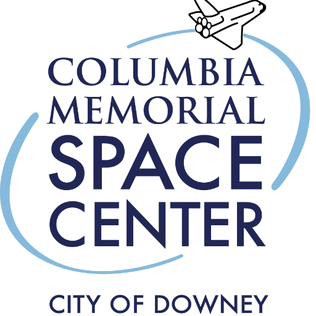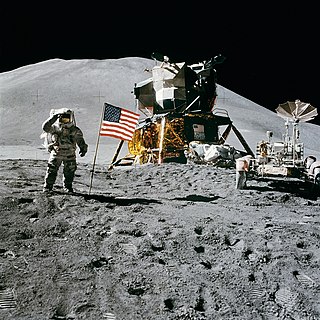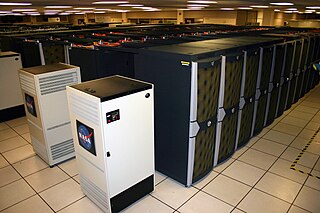
The Ames Research Center (ARC), also known as NASA Ames, is a major NASA research center at Moffett Federal Airfield in California's Silicon Valley. It was founded in 1939 as the second National Advisory Committee for Aeronautics (NACA) laboratory. That agency was dissolved and its assets and personnel transferred to the newly created National Aeronautics and Space Administration (NASA) on October 1, 1958. NASA Ames is named in honor of Joseph Sweetman Ames, a physicist and one of the founding members of NACA. At last estimate NASA Ames has over US$3 billion in capital equipment, 2,300 research personnel and a US$860 million annual budget.

The Space Race refers to the 20th-century competition between two Cold War rivals, the Soviet Union (USSR) and the United States (US), for dominance in spaceflight capability. It had its origins in the missile-based nuclear arms race between the two nations that occurred following World War II, aided by captured German missile technology and personnel from the Aggregat program. The technological superiority required for such dominance was seen as necessary for national security, and symbolic of ideological superiority. The Space Race spawned pioneering efforts to launch artificial satellites, uncrewed space probes of the Moon, Venus, and Mars, and human spaceflight in low Earth orbit and to the Moon.

Splashdown is the method of landing a spacecraft by parachute in a body of water. It was used by American manned spacecraft prior to the Space Shuttle program, and is planned for use by the upcoming Orion Multipurpose Crew Vehicle. It is also possible for the Russian Soyuz spacecraft to land in water, though this is only a contingency. The only example of an unintentional manned splashdown in Soviet history is the Soyuz 23 landing.

Cape Canaveral Air Force Station (CCAFS) is an installation of the United States Air Force Space Command's 45th Space Wing.

Robert Rowe Gilruth was an American aerospace engineer and an aviation/space pioneer who was the first director of NASA's Manned Spacecraft Center, later renamed the Lyndon B. Johnson Space Center.

The Constellation Program is a cancelled manned spaceflight program developed by NASA, the space agency of the United States, from 2005 to 2009. The major goals of the program were "completion of the International Space Station" and a "return to the Moon no later than 2020" with a crewed flight to the planet Mars as the ultimate goal. The program's logo reflected the three stages of the program: the Earth (ISS), the Moon, and finally Mars—while the Mars goal also found expression in the name given to the program's booster rockets: Ares. The technological aims of the program included the regaining of significant astronaut experience beyond low Earth orbit and the development of technologies necessary to enable sustained human presence on other planetary bodies.

Cosmosphere is a space museum and STEM education center in Hutchinson, Kansas, United States. It was previously known as the Kansas Cosmosphere. The museum houses over 13,000 spaceflight artifacts - the largest combined collection of US and Russian spaceflight artifacts in the world, and is home to internationally acclaimed educational programs.

The Kennedy Space Center Visitor Complex is the visitor center at NASA's Kennedy Space Center in Florida. It features exhibits and displays, historic spacecraft and memorabilia, shows, two IMAX theaters, and a range of bus tours of the spaceport. "Space Shuttle Atlantis" is home to the real Space Shuttle Atlantis orbiter and the Shuttle Launch Experience, a simulated ride into space. The center also provides astronaut training experiences, including a multi-axial chair and Mars Base simulator. The visitor complex also has daily presentations from a veteran NASA astronaut. A bus tour, included with admission, encompasses the separate Apollo/Saturn V Center. There were 1.7 million visitors to the visitor complex in 2016.

A boilerplate spacecraft, also known as a mass simulator, is a nonfunctional craft or payload that is used to test various configurations and basic size, load, and handling characteristics of rocket launch vehicles. It is far less expensive to build multiple, full-scale, non-functional boilerplate spacecraft than it is to develop the full system. In this way, boilerplate spacecraft allow components and aspects of cutting-edge aerospace projects to be tested while detailed contracts for the final project are being negotiated. These tests may be used to develop procedures for mating a spacecraft to its launch vehicle, emergency access and egress, maintenance support activities, and various transportation processes.

Space Center Houston is a leading science and space learning center, the official visitor center of NASA Johnson Space Center in Houston and a Smithsonian Affiliate museum. The organization is owned and operated by the nonprofit Manned Spaceflight Education Foundation, a 501(c)(3) organization. The Johnson Space Center is the home of Mission Control and astronaut training.

The following outline is provided as an overview of and topical guide to space exploration:

NASA's Christopher C. Kraft Jr. Mission Control Center, also known by its radio callsign, Houston, is the facility at the Lyndon B. Johnson Space Center in Houston, Texas that manages flight control for America's human space program, currently involving astronauts aboard the International Space Station (ISS). The center is in Building 30 at the Johnson Space Center which is named after Christopher C. Kraft Jr., a retired NASA engineer and manager who was instrumental in establishing the agency's Mission Control operation, and was the first Flight Director. Prime contractor for systems integration at Houston was Philco Corp., selected by NASA in January 1963.
The Mercury-Redstone Launch Vehicle, designed for NASA's Project Mercury, was the first American manned space booster. It was used for six sub-orbital Mercury flights from 1960–61; culminating with the launch of the first, and 11 weeks later, the second American in space. The fourth subsequent Mercury human spaceflights used the more powerful Atlas booster to enter low Earth orbit.
With the advent of unmanned and manned space flight a new era of American history had presented itself. Keeping with the tradition of honoring the country's history on U.S. postage stamps, the U.S. Post Office began honoring the various events with its commemorative postage stamp issues. The first U.S. Postage issue to depict a U.S. space vehicle was issued in 1948, the Fort Bliss issue. The first issue to commemorate a space project by name was the ECHO I communications satellite commemorative issue of 1960. Next was the Project Mercury issue of 1962. As U.S. space exploration progressed a variety of other commemorative issues followed, many of which bear accurate depictions of satellites, space capsules, Apollo Lunar Modules, space suits, and other items of interest.

The Virginia Air and Space Center is a museum and educational facility in Hampton, Virginia that also serves as the visitors center for NASA's Langley Research Center and Langley Air Force Base. The museum also features an IMAX digital theater and offers summer aeronautic- and space-themed camps for children.

The Columbia Memorial Space Center (CMSC) is a science museum owned and operated by the City of Downey, California. Located on 12400 Columbia Way in Downey, it is open to the general public as hands-on space museum and activity center in the Los Angeles area.
Journey Through the Solar System was a 13-episode documentary series produced by NASA's Lewis Research Center in 1983. Each half-hour episode contained the entirety or clips of older NASA films with framing host footage with Larry Ross, Director of Space Science at Lewis.































